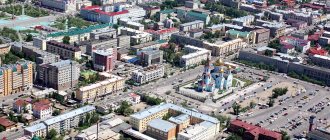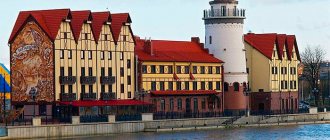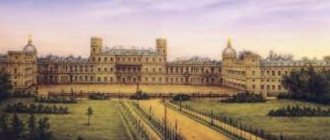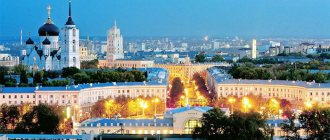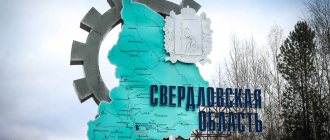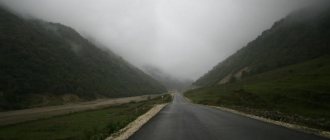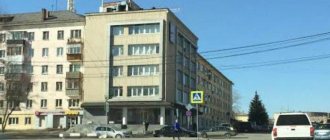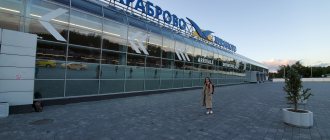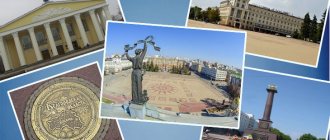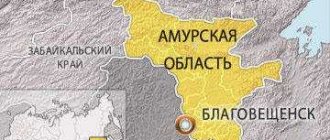City of Kaliningrad (formerly Koenigsberg) occupies the position of a semi-exclave in relation to the Russian Federation: they do not have a common border. The region neighbors Lithuania and Poland and has direct access to the ice-free Baltic Sea. This convenient location allows the city area to have sustainable development. In recent years, Kaliningrad has been recognized several times as the best Russian city.
Königsberg Castle (“royal mountain”), which arose in the second half of the 13th century, is closely connected with the history of the knights of the Teutonic Order. It was they who moved their capital here from Poland. And then they contributed to the development of the Duchy of Prussia, where power belonged entirely to the church hierarchy. Cities flourished around the fortress:
- Altstadt
- Lebenicht
- Kneiphof
They were destined to unite with Koenigsberg, which became the capital of the Prussian state in 1724. A few years later, the capital of Prussia briefly became a Russian city as a result of the defeat of the “Prussians” by Russian troops in the Seven Years’ War.
Historians tend to assess the four-year period of Russian rule as positive for the development of the city. The industrialization of Koenigsberg began later, when woodworking and shipbuilding began to develop.
By the beginning of the First World War, the city had become a major international trading port and at the same time was a German exclave after Germany's defeat in the war. It was separated from the country by the Polish corridor. This affected the development of the territory: Koenigsberg was the most backward German city due to its distance from Germany. This is how he entered the Second World War.
In 1944, British aircraft destroyed the central part of the city, historical monuments and thousands of civilians were damaged. In April 1945, Soviet troops under the command of Marshal Vasilevsky successfully completed the assault on Koenigsberg, achieving the complete surrender of German troops.
The future fate of the Prussian city was finally decided after the complete victory of the Soviet troops - according to the Potsdam decision, part of the Prussian lands, along with Koenigsberg, went to the Soviet Union, and in July 1946 the city was renamed Kaliningrad and became the center of the region of the same name. A new era began in the history of the ancient Prussian city.
Recent history of Kaliningrad
During the Soviet period, the development of Kaliningrad will highlight several stages:
- The Great Migration of Peoples. In 1946, at the call of the government, citizens from all Soviet republics began to move to the Kaliningrad region. This determined the multinational composition of the region. The Germans left the city and rushed to Germany.
- The fight against devastation. Kaliningrad was almost completely destroyed: enterprises, transport, water supply and sewage systems did not function. The settlers had to work hard to restore the national economy, buildings and residential buildings. Their work was appreciated by an award - the Order of the Red Banner of Labor.
- In isolation. With the collapse of the USSR, the situation in the regional center and the entire region worsened. With the entry of Lithuania into the European Union, Russian citizens could not enter the region without a foreign passport and visa. In order to develop the isolated territory, the Russian government is carrying out a set of events related to the 750th anniversary of the city’s founding and the 60th anniversary of its entry into Russia.
- From support to development. In 2003-2007, the region improves its indicators of socio-economic development, becoming the second region (after St. Petersburg) in the Northwestern Federal District. Receives recognition from the Council of Europe.
- Industrial giant. In the region, passenger cars and complex household appliances are being assembled, furniture production is developing, and enterprises in the light and food industries are strengthening their positions. Shipbuilding is further developed at JSC Baltic Shipbuilding. A special economic zone regime is being introduced in the region, in which 34 thousand enterprises of various types of property operate. 67 percent of all enterprises are concentrated in Kaliningrad.
Immanuel Kant Island
This is the historical center of Königsberg. It is an island formed by the branches of the Pregolya River. Its former name was Kneiphof, from Prussian “surrounded by water.” In Soviet times it was simply called Central Island. The modern name of Kant Island is due to the fact that the great philosopher lived here and was buried.
The heart of the city was almost completely destroyed during the war during the bombing of British aircraft - only the Cathedral survived. The rest was occupied by a park. For tourists there will be both pieces of antiquity and new interesting objects.
Immanuel Kant Island today: most of it is occupied by a park, dominated by the famous cathedral.
Population and climate
About 450 thousand people live on an area of 220 square kilometers, according to official data. In fact, the population of Kaliningrad has exceeded half a million citizens due to legal labor migrants from the republics of the former Soviet Union.
According to national composition, the following people live in Kaliningrad:
- Russians
- Ukrainians
- Belarusians
- Armenians
- Tatars
- Lithuanians
- Germans
- Poles.
It should be noted that the former indigenous peoples in the structure of the national composition of Kaliningrad make up half a percent - about 2 thousand people.
Kaliningrad was recognized as the best city in Russia in terms of amenities and a place where it is pleasant to live. The unemployment rate in the regional center does not exceed 0.5 percent, while in the region this figure was 1 percent of the economically active population (as of the end of 2014). More than half of the unemployed are women of working age. 38 percent of the number of unemployed Kaliningrad residents are rural residents.
There is an oversupply of certified lawyers and electronic equipment installers in the labor market. Medical workers and construction workers remain in demand on the labor market.
Half of all pensioners in the region live in Kaliningrad - more than 120 thousand people. The average salary in Kaliningrad is 32 thousand rubles, which is 2.5 thousand rubles more than in the region as a whole. The highest salaries - up to 45 thousand rubles - are at mining enterprises.
The climatic conditions in the region can be called favorable. The weather is influenced by the ice-free Baltic Sea and the warm Gulf Stream. Winter here is warmer than on mainland territories, spring is early and long. The same can be said about autumn, the beginning of which coincides with the calendar. The swimming season in the Baltic begins in mid-June - the summer period is moderately cool.
Kaliningraders love the mild Baltic winter, the average temperature of which is around zero degrees. The January weather is often marred by severe storms. Extremely low January temperatures are rather an exception. Despite the proximity of the sea, air humidity in average annual values does not exceed 80 percent.
Ecology of Kaliningrad
The main sources of air pollution within the city are transport. In terms of availability of personal passenger transport, Kaliningrad ranks 5th in the Russian Federation. There are almost 350 vehicles per thousand inhabitants. The most unfavorable streets in the city in terms of nitrogen oxide content:
- Gorkogo Street
- Dzerzhinsky Street
- Victory Avenue
- Peace Avenue
- Sovetsky Prospekt
- Leninsky Prospekt
With changes in traffic flows and their redistribution from the central part of the city, the environment has been significantly improved.
Leningradsky is considered the best area to live, where new residential complexes are located in green areas.
Investments in the economy
Kaliningrad is a favorable city for investment. Not only all-Russian cash flows flow here, but also foreign capital. Investors invest money in industry, development of transport infrastructure and communications.
Large investment flows are aimed at the reconstruction of the Khrabrovo international airport, which, with its dilapidated appearance, terrified visitors to the city. The project provides for the development of both an airport terminal and a multifunctional commercial complex. The development of the international airport’s infrastructure has begun at a very opportune time – it will provide comfortable conditions for those arriving for the 2021 FIFA World Cup. How the gateway of the city will improve the investment attractiveness of the region. Until mid-2013, the shabby terminal building caused a lot of criticism from city guests.
Projects to create investment brands have been successfully implemented in Kaliningrad:
- LLC "Ivan Taranov Breweries"
- CJSC Almazholding
- LLC "Lesobalt"
- JSC Avtotor
- LLC "Fish Village"
According to the Ministry of Regional Development of the Russian Federation, there are over 40 investment sites in the region. The largest project accumulated 12 billion rubles - the construction of a new housing complex in the village of Kholmogorovka.
As a result of the implementation of a promising project to create an eco-agricultural park, up to 4.5 thousand new jobs will be created. Innovations in the amount of 9 billion rubles are part of the Russian program.
The investment plans of the special economic zone include expanding the production of German BMW cars, creating 2 thousand new jobs and 11 billion investments in fixed assets.
Budget processes
The budget of the Municipal Municipality "City of Kaliningrad" consists mainly of its own income. During the first half of 2014, the city treasury received 4.8 billion rubles; expenditures exceeded the treasury's capacity by half a billion rubles.
2014 was not a favorable period for social projects. The reason is banal – lack of budget funds. It was decided to use money from the city treasury to develop design estimates for the construction of facilities for the upcoming World Cup. This decision was made by deputies in order to receive federal funding for the construction of the facilities themselves. Although, it should be noted that the city has good budget indicators.
The city treasury for 2014 is as follows:
- The revenue part is 9.4 billion rubles, the municipality’s own income is 7.4 billion rubles
- Subsidies from the regional treasury - 2 billion
- Budget deficit 125 million rubles
- The national debt as of January 1, 2015 (forecast) is 7 billion rubles. Almost equal to annual own income.
Migration
For 20 years, the city has been one of the six main centers of internal migration activity among the regions of the Russian Federation. This factor provides a positive balance in the demography of Kaliningrad and the region: by January 1, 2021, the population over the previous 3 years grew by 2.7% (to 1012.5 thousand people). The natural decline (minus 6 thousand) was more than covered by the migration increase of 32.1 thousand people.
Districts and transport of Kaliningrad
Previously, Kaliningrad was divided into five administrative districts. Today there are only three of them:
- Central. The largest district in terms of area, but not in terms of population density. During the war, the territory of this part of the city suffered the least from bombing - German-built buildings have been preserved here. The Central District is home to the Kaliningrad Drama Theater and one of the largest zoos in the world. Public transport is well developed, connecting the area with the Moscow and Leningrad regions.
The Northern railway station is also located here.
- The Moscow region is located in the “golden mean” in terms of area and population. In 2009 it was merged with the Baltic region. The area is connected to the central part by bus and trolleybus services. The journey takes about half an hour. The largest investment project “Fish Village” is being implemented in the district - the construction of a complex of buildings in the style of an ancient Prussian town. There are two ports and three harbors within the district's borders.
- Leningradsky district is the most densely populated, but is smaller in area than the other two districts. The territorial center of the city, where many attractions are located:
- Royal castle and gate
- Defensive tower of the Don, where the Amber Museum is now located
- Wrangel Tower.
The main transport routes leading to Khrabrovo airport and connecting the city with the seaside run through the area. The territory has a well-developed bus service, but during peak hours there are often traffic jams on Narvskaya and Gorky streets.
Train Station
Kaliningrad-Pasazhirsky railway station is the main station in the city, serving long- and short-distance trains. The number of platforms at the railway station is 6, the total number of tracks is 11. The station is located at st. Zheleznodorozhnaya, 13-23. The station opened in 1929. In the railway station building, passengers have access to ticket offices, a spacious waiting room, a buffet, and a storage room for luggage and personal belongings.
The most popular long-distance train destinations: Svetlogorsk, Sovetsk, Mamonovo, Baltiysk, Minsk, Moscow, St. Petersburg, Rostov-on-Don, Smolensk, Adler, Chelyabinsk, Orsha.
New residential complexes and housing costs
Kaliningrad is experiencing a real housing construction boom with the arrival of the large federal developer SU-155 in the region. The company is carrying out comprehensive development of microdistricts. One of the most famous is the construction of the Vremena Goda residential complex. At the excavation stage, citizens could buy housing here for 27 thousand rubles per square meter. As the territory was improved, the cost of housing rose to 40 - 45 thousand rubles per square meter.
In 2013, more than 6.5 thousand comfortable apartments were commissioned in Kaliningrad.
Advantages of living in the Vremena Goda residential complex:
- Convenient layout of a residential area with shops and cafes within walking distance, there are kindergartens and schools
- Comfortable apartments oriented to all cardinal directions
- High ceilings up to 2700 centimeters, plastic windows
- High-speed German elevators
- Covered secure parking for each house, a large number of parking spaces next to the house. Residents can move the car during the day so that it always remains in the shade
- Landscaped area with children's and sports grounds, a swimming pool and a fountain, sculptural compositions
- A huge number of flowers, shrubs, trees. The residents do the landscaping themselves. They also keep the neighborhood clean. Dog walking areas have containers with plastic bags and gloves.
Residential complex "Solnechnaya Gorka":
- Built according to an individual project from block sections of variable number of storeys
- The territory of the complex is fenced and landscaped
- Sufficient parking spaces for cars of residents and their guests
- Excellent ecology - several ponds and a lake are located nearby, many green spaces
- Walking distance to a clinic, shops, kindergartens, schools
- Excellent transport accessibility - you can be in the city center in 7-10 minutes
- You can buy a two-room apartment for 2.3 million rubles.
Residential complex "Green Island":
- Monolithic 9-story residential buildings are located compactly within the boundaries of the Leningradsky district
- Developed infrastructure - includes more than twenty facilities
- Landscaped area with large parking lots for cars.
Residential complex "New Selma":
- Monolithic 7 - 9-storey houses according to an individual project
- The facades are finished with clinker tiles
- On the ground floors of the houses there are public spaces (pharmacies, cafes, shops, hairdressers)
- More than 300 thousand square meters of economy class housing will be built on a site of 40 hectares
- Prices from the developer are 36 thousand rubles per square meter
- Apartments are sold under the military mortgage program
- Comprehensive landscaping of the entire territory is provided (sports and children's playgrounds, flower beds, lawns).
Residential complex "New Kholmogorovka"
- A plot of land has been allocated in the suburbs for the construction of low-rise housing - up to four floors high
- There are plots for individual residential development
- In 2014, the construction of utility networks began
- Autonomous heating is provided for all apartments
- A school for a thousand places, two kindergartens with swimming pools will be built.
Budget housing prices at the beginning of 2015 start at 35 thousand rubles per square meter. These are residential complexes in Kaliningrad:
- "Aldan pines"
- "Smolny Park"
- "New Selma"
- "Summer"
- "Legends of the Sea".
Luxury housing in residential complexes costs from 55 thousand to 65.7 thousand:
- "House on Lipovaya Alley"
- "Prestige"
- Residential complex on Herzen Street
- "Georgievsky"
- "Vienna Quarter"
The average price range (from 40 to 50 thousand rubles per square meter) is for new buildings in residential complexes:
- "Youth"
- "Outpost"
- "East"
Physiographic indicators
It is no coincidence that many years ago the population of Kaliningrad began to grow rapidly. People were attracted by the proximity to the Pregolya River. Now the city is located on both its banks. There are many water bodies here that can improve the state of the environment. These are various ponds, streams and lakes.
The locality lives according to Kaliningrad time. The offset relative to Moscow is two hours ahead. The city's climate changes from maritime to continental. Winters here are much warmer than in the Russian capital. Sometimes you have to wait several months for snow. But in the summer it is quite hot here. It is no coincidence that there are many health resorts near the city.
Attractions
The city has a difficult historical fate, a unique architectural appearance that attracts tourists from different parts of the world. There are more than five hundred cultural and historical heritage sites in Kaliningrad.
You can get acquainted with the life of the Prussian city by visiting its fortifications, the Cathedral, where numerous museum exhibitions of the history of Koenigsberg are presented. The famous philosopher Emmanuel Kant is buried under its walls - his name is inscribed on a well-preserved tombstone.
Kaliningrad is considered an amber region - the only Amber Museum in Russia has been created here. He settled in a historical building - the defensive tower of the Don. The historical building has nothing in common with the famous Russian river - it is also associated with the name of the Prussian field marshal Friedrich Karl Don.
The largest exhibition of one mineral is located on a thousand square meters.
Amber is everywhere in Kaliningrad - it will be offered to you at the entrance to the museum, on the embankment, in souvenir shops, at train stations and at the airport. These can be either souvenirs or raw stone, from which local residents prepare a healing tincture.
A sea city cannot do without a corresponding fetish - there is a Museum of the World Ocean in Kaliningrad. Models of many historical ships have been recreated here. In April, the museum hosts the townspeople’s favorite holiday – Herring Day.
The most visited tourist sites:
- The Kaliningrad Zoo is one of the largest in Russia and consistently ranks among the world's best zoos. More than three thousand animals of 300 species exist peacefully here. Most of them are included in the Red Book
- The Fish Village complex is an embankment and a dozen and a half buildings made in various styles of the old Prussian city. There is also a pedestrian drawbridge here. The embankment hosts Craftsman Day (May) and Cat Day, timed to coincide with the beginning of the school year.
The Cathedral of Christ the Savior is a new symbol of the ancient city, its decoration.
Konigsberg Castle
This castle was amazing - powerful, mysterious, beautiful. This is where Koenigsberg began.
Another name for the castle is Royal, built in the 13th century during the reign of the Czech king Ottokar II. It was also called the Order Castle, since for a long time it was the residence of the Teutonic Order. Later it became a palace for the Prussian kings, the seat of the Prussian government. The castle was expanded and rebuilt many times, combining features of a variety of architectural styles. The tallest tower, built in the 19th century in the Gothic style, rose 80 meters above the city.
Royal castle at the beginning of the 20th century.
During the bombing of the city, the castle was destroyed. All that remained was something that resembled a skeleton - partially intact tower walls without a roof or windows.
It is known that the disappeared Amber Room was taken by the Nazis from Leningrad here, but no traces of it were found. In addition, the castle had a large network of cellars and dungeons. All this aroused great interest among residents and guests; they were constantly trying to look for something in the ruins.
Unfortunately, in 1967 the city authorities decided to destroy the ruins. Every wing and every wall was blown up. It was planned to build a house of councils on this site; the unfinished building now rises above the foundations of the castle.
In recent decades, a number of attempts have been made to restore the Royal Castle. Archaeological excavations were carried out. A museum was organized - an observation deck. Today you can see the destroyed, exposed base of the massive structure, but you cannot get there directly. The exhibition that you can get acquainted with is pieces of masonry collected from all over the blown up castle with a description of what part they made up. The bulk of the debris was used in the construction of city buildings and houses during the years of Soviet power.
The remains of the towers and walls of the majestic Königsberg Castle against the backdrop of the unfinished House of the Soviets
Education
There are more than 180 municipal educational institutions in Kaliningrad:
- Preschool educational institutions
- Secondary schools
- Children's institutions of additional education (art, music schools)
- Teen clubs
- Sports schools
- Private and non-state educational institutions.
There are 21 higher education institutions providing education in the city. The most famous of them:
- Immanuel Kant Baltic University
- Baltic Academy of Fishing Fleet
- Higher Marine Engineering School
- Baltic Naval Institute
- Kaliningrad Border Institute
A branch network of secondary specialized educational institutions has been developed. Some of them operate on the basis of industry universities.
Other city gates
Also in Kaliningrad you can visit, look and take pictures against the backdrop of other city gates:
- Friedland's
- Friedrichsburg
- Asufalskikh
- Railway
- Zakheimsky
- Royal.
Today the gates are used for different purposes - most often they serve as museums.
The Royal Gate was a symbol of the city's 750th anniversary celebrations in 2005.
